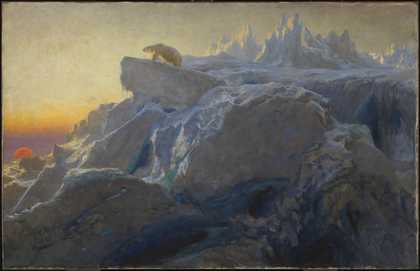
Briton Riviere
Beyond Man’s Footsteps (exhibited 1894)
Tate
Briton Riviere’s Beyond Man’s Footsteps was shown at the Royal Academy in 1894 (fig.1).1 The artist depicts an Arctic region so remote that humans have never been there, though the spectator can wander into it in imagination. There are two forking sight lines which lead us through the shadowy foreground to the splendours of the sunset sky and to the distant icy peaks still touched with gold: according to an early description of the painting, the rays of the ‘sinking sun … cause the ice-needles to scintillate with light’.2 As though by chance we also see in the distance a solitary polar bear, which contemplates the panoramic view: the abyss at the foot of the iceberg and the vivid reds, pinks and lilacs in which the sun is enveloped as it disappears into the murk on the horizon. As in many paintings of wild animals dating from the last decades of the nineteenth century, the bear, although no doubt drawn from one seen in Zoological Gardens at Regent’s Park, is seemingly absorbed into its natural environment.3 Yet it seems to gaze and reflect on the scene like a human being. In this virginal terrain ‘beyond man’s footsteps’, we project our sensibilities onto the animal, and, as it were, see through its eyes, enter into its experience.4
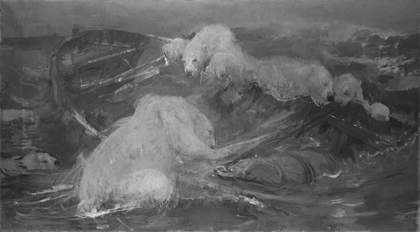
Fig.2 John Macallan Swan
The Abandoned Boat c.1870–1910
Oil on canvas
© Collection Rijksmuseum, Amsterdam
Another animal painter, John Macallan Swan, also showed the fascination of this kind of subject at the time. His picture entitled (quoting Coleridge’s Rime of the Ancient Mariner) We were the First that ever Burst / Into that Silent Sea depicted polar bears swimming among icebergs. According to a writer of 1897, Swan captured the spirit of ‘the dreary waste of grey, verily a region still unmastered by human skill and courage’ simply by representing its fierce but magnificent ‘lone occupants’, the bears, their ‘black snouts and keen small eyes’ just visible above the surface of the water.5 In Swan’s The Abandoned Boat (fig.2), the bears grapple a half-submerged rowing boat. Its former human occupants – shipwrecked whalers or starving explorers – are presumed to have perished, leaving this icebound region to its only natural inhabitants.6
The scenes represented by Riviere and Swan belonged to a well-established genre: in the nineteenth century the Arctic and its creatures had become popular and highly emotive themes in the arts.7 Consciousness of human destruction of the environment, which the threat to polar bears has come to symbolise today,8 still lay in the future, but already there was the sense of violating a pristine world, often with tragic results. What one journalist of 1861 called ‘that mysterious temple which sits forever upon the forehead of the world’ was a place of wonder,9 inspiring religious awe, but also a place of ever-present danger of sudden or lingering death. In this essay I shall analyse images of the Arctic, especially those that refer to the loss of Sir John Franklin’s expedition. I am interested in what they reveal about changing notions of the sublime in the nineteenth century. In particular, I shall discuss concepts of the animal sublime through representations of polar bears in art and literature.
The disappearance of Sir John Franklin’s expedition with the loss of all the men on his two ships, the Erebus and Terror, obsessed the public in both Britain and America. They had set out in 1845 to undertake a renewed search for the North-West Passage, but all trace of them seemed lost until some troubling relics came to light in the late 1850s.10 As Russell Potter has shown, the fascination with Franklin’s fate was reflected in popular panoramas, in illustrated journals, and in the wide sales of books published by the leaders of various search and rescue expeditions in the 1850s. These books were often vividly illustrated by professional artists, working from sketches made by naval officers who had actually been on the expedition in question.11
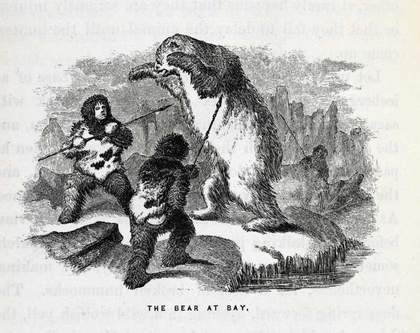
Fig.3 ‘The Bear at Bay’
Wood engraving from Elisha Kent Kane, Arctic Explorations in the Years 1853, ’54, ’55 1856
By permission of The British Library (2370 E8)
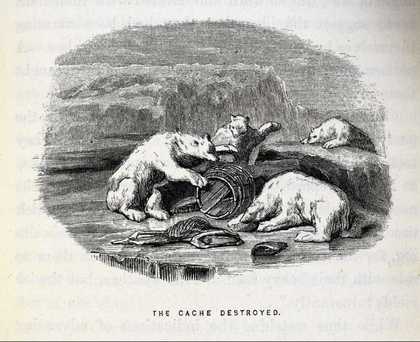
Fig.4 ‘The Cache Destroyed’
Wood engraving from Elisha Kent Kane, Arctic Explorations in the Years 1853, ’54, ’55 1856
By permission of The British Library (2370 E8)
The books include many descriptions of encounters with polar bears. The men were struck by the strong bonds that linked family groups of these animals – especially the hungry females and cubs which were attracted to the ships – but nevertheless killed them without mercy.12 In the American Elisha Kent Kane’s Arctic Explorations in the Years 1853, ’54, ’55, some vignettes depict hunted bears at bay, attempting to resist dogs and spears, but in The Cache Destroyed the animals exact retribution as they raid an expedition’s food store, jeopardising the men’s ultimate survival (figs.3 and 4).13 We also gain an impression of other awe-inspiring sights of the Arctic – looming icebergs, darkness at noon, the aurora borealis – and of the fragility of expeditionary ships which might at any moment be crushed by the ice. James Hamilton’s image in Kane’s book of The Nip off Cape Cornelius Grinnell, Forge Bay shows human enterprise and ambition pitted against the terrible power of the elements, as the men tug desperately to free the ship and pull it to open water, under a menacing sky.14 ‘A Funeral on the Ice’ illustrated Sir Francis M’Clintock’s best-selling The Voyage of the ‘Fox’ in the Arctic Seas (1859, fig.5), the narrative of an expedition which had brought the first firm news of the fate of Franklin and his men. In line with M’Clintock’s emphasis on the religious and patriotic inspiration for his endeavour, it shows the decent Christian burial of a crew member who had been killed in an accident: the orderly rituals of civilised life are, it seems, preserved even in this unearthly and fearful environment, as the strange Arctic phenomenon of the paraselene or false moons arches over the funeral party.15 As we shall see, the finds made by M’Clintock and others of the relics of Franklin’s expedition told a very different story.
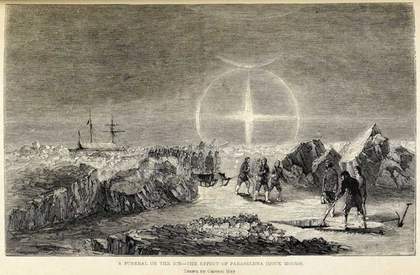
Fig.5 Edmund Evans after Captain May
‘A Funeral on the Ice – The Effect of Paraselena (Mock Moons)’
Wood engraving from Sir Francis Leopold M’Clintock, The Voyage of the ‘Fox’ in the Arctic Seas, 1859
By permission of The British Library (10460 D2)

Fig.6 Frederic Edwin Church
The Icebergs 1861
Oil on canvas
© Dallas Museum of Art
The dread of disaster is present, even in images that seem to evoke only the intense beauty of the polar landscape. Frederic Church’s The Icebergs 1861 (fig.6) originally represented a scene with absolutely no sign of human or animal life, but the artist painted in the broken mast of a ship when the picture was shown in London in 1863, as an allusion to the tragedy of Franklin’s lost men.16 For Church, the Arctic is the sublime dwelling-place of God, into which humans venture at their peril. He has chosen to depict the light of a glowing sunset, which transfigures the ice with dazzling colours, and makes the sea and sky look dark by comparison, except where the water appears bright green in the shallows. We are given the illusion of actually standing on an iceberg which extends beneath the water, and are dazed by the realistic rendering of an optical impression: strangeness is reinforced by spectacular immediacy.17 To accompany the picture, there was a book written by Church’s friend, the Revd Louis Noble, After Icebergs with a Painter. Noble had accompanied the artist on a boat trip to Newfoundland and Labrador in the summer of 1859 to study the formation and effect of the icebergs close up, and he frequently described the terrible dangers they ran. Yet the tone of the work is ecstatic. The icebergs are constantly on the move, constantly transformed by the fitful light and the dynamic process of dissolution. The sense of flux in nature is modern, even Darwinian. But for Noble and Church, the primary meaning of what they saw was not scientific but transcendental. These ‘shadowy sublimities … crystalline vessels are freighted with God’s power and glory, and must be reverently and thoughtfully studied … After all, how feeble is man in the presence of these Arctic wonders’. He ‘may no more lay his hand upon them than the Jew of old might … upon the ark of the covenant’. Although the ice was ‘perishable as a cloud’, its pure whiteness made them think of Christian redemption through the blood of the Lamb, its jewel-like colours resembled the walls of the New Jerusalem as described in the Book of Revelation. ‘I said aloud but low: “The City of God! The sea of glass! The plains of heaven!”.’18
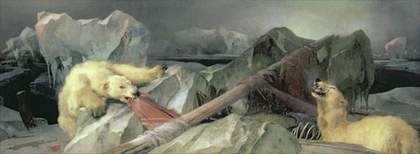
Fig.7 Sir Edwin Landseer
Man Proposes, God Disposes exhibited 1864
© The Bridgeman Art Library; Royal Holloway College, University of London
In 1864, the year after Church’s Icebergs was shown to great acclaim in London, Sir Edwin Landseer exhibited at the Royal Academy one of his most startling works, Man Proposes, God Disposes (fig.7).19
Like Church, Landseer alludes to the tragic fate of the Franklin expedition, but the subject is treated in a very different spirit. Landseer’s title seemingly conveys humble submission to the divine will and faith in the workings of Providence, but, given his known disdain for conventional pieties in art, this can only be ironic.20
Rather than picturing the ethereal beauty of the land that formed Franklin’s grave, Landseer gives us a realistic close-up of two polar bears – like ‘monster ferrets’, one reviewer thought – tearing the improvised shrouds and chomping ravenously on the ribs of the dead men, their breath steaming in the bitter-cold air.21
As we have seen, it was well known that bears did invade the food stores of Arctic explorers and disturb their goods, especially, Captain M’Clintock explained, any vertical objects such as stashes of oars.22
Opinions varied as to whether they ate human remains, but it was thought they might do so when themselves starving.23
Here their diet of bare bones suggests such an extreme of hunger, evoking the starvation of the men themselves. But there is a closer connection with the reports of the expeditionary leaders who first discovered what had happened to Franklin’s party. Captain John Rae, of the Hudson’s Bay Company, heard from Inuit people that there had been cannibalism among the last survivors, indicated by mutilated bodies and bones in kettles – an assertion that has been borne out by modern research.24
In 1854, Dickens in Household Words had attempted to refute this allegation on grounds of ‘moral improbability’. At the same time, however, he alluded to several instances of such cannibalism in fact and fiction, notably Franklin’s own account of an earlier Arctic expedition when one of the men ‘did conceive the horrible idea of subsisting on the bodies of the stragglers, if not of even murdering the weakest with the express design of eating them’. Rae was allowed to reply to Dickens, and his report on his discoveries was printed in full, despite the revulsion of Franklin’s widow and the blow to British patriotism.25
Given the public notoriety of Rae’s report, it is impossible not to see in Landseer’s ferocious and amoral beasts a symbolic stand-in for the human cannibals, even though the animals’ actions are ostensibly a denial that humans were implicated in the deed. The dislocation which Landseer conveys is not only the literal dismemberment of the corpses, but a deliberate tearing of the fabric of patriotic rhetoric, religious sentiment and idealism so evident in sanctioned reports on the finds.
There is an insistent materiality in Landseer’s imagined scene, but there is also a sense of futility in the objects which surround the skeletons. Sir Francis M’Clintock, while diplomatically silent on Rae’s allegations of cannibalism, gave a detailed description of one find which ‘transfixed us with awe’. It was a boat that had been hauled overland on runners in a vain attempt to reach the Back River, containing two bodies. Both lacked their skulls, and one was a pile of disjointed bones. But the other more complete skeleton, evidently that of a stronger man, was surrounded by objects that he had salvaged from the expedition: perhaps – the reader could only surmise – he had stripped them from men he had eaten. They were both pathetic and bizarre, even ludicrous: not just furs, boots, guns and chocolate, but Captain Franklin’s inscribed silver plate, ‘worked slippers’, silk handkerchiefs, ‘scriptural or devotional works’ and – strangest of all – a copy of Goldsmith’s The Vicar of Wakefield.26
The fragility of civilisation, its utter irrelevance in this heart of darkness, could hardly have been more poignantly conveyed. Admittedly, Landseer does not show any improving literature or embroidered slippers among his scatter of objects. However, the telescope, the shreds of a coat or flag and the sail scattered round the human bones, which William Michael Rossetti called ‘the saddest of membra disjecta’, are telling enough.27
Landseer’s picture was cold-shouldered by Lady Franklin and the Admiralty, but it was greatly admired by reviewers and the general public.28
Admittedly, critics writing about Landseer’s art in retrospect a few years later, when his reputation was beginning to be questioned, sometimes remarked that the gruesome literalism of Man Proposes, God Disposes came very close to vulgar melodrama,29
but, at the time of its first exhibition, horror did not seem inimical to exalted emotion. The Art-Journal described its ‘poetry, pathos, and terror’, its ‘tragic grandeur’. The Athenaeum found ‘epic’ quality, the Spectator enthused about the ‘living fire of imagination’, and the Saturday Review about ‘the force and height of the idea … sublimity of sentiment’.30
Many of the traditional attributes of the sublime as defined by Edmund Burke in his Philosophical Enquiry into the Origin of Our Ideas of the Sublime and Beautiful of 1757 are indeed present here: the terror arising from darkness, solitude, obscurity and confusion; a sense of great undefined spaces stretching beyond the lateral limits of the picture; ferocious beasts, which like the Arctic itself, convey a sense of uncontrollable and menacing power.31
Yet in many ways Landseer’s image offers a deliberate challenge to earlier ideas of the sublime, as formulated notably by Burke and Kant.
Burke has often been hailed as an empiricist who analysed our impressions of the sublime and beautiful principally on a physiological or psychological basis.32
However, he largely rejected an associative element, and hence the likelihood of subjective diversity, in our responses to objects and natural phenomena. His insistence that all humans are affected in the same way by ‘the natural properties of things’ introduced an element of determinism into the Enquiry: the ‘great chain of causes’ through which human physiology was connected ‘even to the throne of God himself, can never be unravelled’.33
Indeed, Burke was convinced that such affects are providential: a sense of the sublime is closely connected with our divinely implanted instinct for self-preservation, and beauty, a spur to sexual passion, relates to our instinct for self-propagation. ‘The more accurately we search into the human mind,’ Burke wrote, ‘the stronger traces we every where find of his wisdom who made it. If a discourse on the use of the parts of the body may be considered as an hymn to the Creator; the use of the passions, which are the organs of the mind, cannot be barren of praise to him’.34
Indeed, an apprehension of God’s power is the ultimate sublime, as Burke showed through many quotations from the Old Testament and from Paradise Lost, terror being mitigated only by a remembrance of His goodness and mercy. The vast visible creation is ‘under the arm, as it were, of almighty power, and invested upon every side with omnipresence … Now as power is undoubtedly a capital source of the sublime, this will point out evidently from whence its energy is derived’.35
In the writings of Kant, notably in the Critique of Judgement, 1790, exalted idealism is even more apparent. For Kant, the sublime is not inherent in any external objects: it exists only in the human mind, in ‘our attitude of thought’, as we become conscious of our own striving for the infinite and the absolute, the dimension of our being that transcends the life of the senses. Nature certainly excites ideas of the sublime in its immense scale, in its ‘chaos or in its wildest and most irregular disorder and desolation … shapeless mountain masses piled in wild disorder upon each other with their pyramids of ice, or the gloomy raging sea’. However, this is because the human observer, temporarily afflicted by a sense of powerlessness and an inability to grasp the totality of what he or she observes, becomes conscious of our ‘supersensible destination, according to which it is purposive and therefore pleasurable to find every standard of Sensibility inadequate to the Ideas of Understanding’.36
The sublime in nature was therefore consistently connected with the moral and the spiritual, as it continued to be for Frederic Church and Louis Noble.37
Nothing could be further from the shocking physicality, the bitter loss of man’s moral dignity, which characterises Landseer’s Man Proposes, God Disposes.
Chauncey Loomis opined, in an essay published over thirty years ago, that ‘Landseer’s image … is quite other than sublime; he has portrayed the brute animal force of Nature, not its inorganic sublimity’.38
Those reviewers who focused on the animals themselves in fact provide us with a clue to the meaning of Landseer’s stark vision of the natural world. William Michael Rossetti, writing in the Fine Arts Quarterly Review, remarked that Landseer had placed ‘the painting of brute life upon a new and higher platform, hardly inferior in lofty suggestiveness to human subjects’, while Fraser’s Magazine thought that ‘the Polar bear will henceforth be a majestic personality in fine art’.39
Burke had indeed discussed wild beasts as one important source of the sublime: ‘ it comes upon us in the gloomy forest, and in the howling wilderness, in the form of the lion, the tiger, the panther, or rhinoceros’.40
In the Book of Job, which Burke so often quoted, the Almighty manifested the immensity of His power most impressively in the fury of the elements and in the magnificent, untameable animals which haunted the earth’s wildernesses.41
This strand in Old Testament thought seemed to contradict the prevalent Christian notion – found notably in Paradise Lost – that all the newly created animals had once peacefully co-existed with the first man and woman in Eden, until they were alienated and made vicious by human sin.42
The glorification of uncontrollable wildness was equally at odds with the anthropocentrism and emphasis on the stable harmony of nature that generally characterised natural theology in the eighteenth and early nineteenth centuries.43
The ferocity of wild beasts made them poetic and exciting, but they could only be viewed by conventionally religious people as rebels against the divine order which would be restored at the millennium. Thus Burke sets such savage creatures in opposition to man, with all his social, loving and compassionate emotions, as the sublime is opposed to the beautiful.44
In Man Proposes, God Disposes, on the other hand, it is the affinity of man and bear under the extremes of hunger that we apprehend.
For Landseer, civilised man is no longer central, no longer the antithesis of nature ‘red in tooth and claw’, but a part of it. Man and bear have at bottom the same needs and urges. In fact, the human-like qualities of polar bears had already been evoked by many writers. There was an extraordinary novella by James Hogg, the so-called ‘Ettrick Shepherd’, author of Confessions of a Justified Sinner and of many yarns about the life of Scottish shepherds and their dogs. Landseer certainly read the latter, and may well have known this story, ‘The Surpassing Adventures of Allan Gordon’, which was included in Hogg’s collected Tales and Sketches in 1837: its mythic qualities seem very germane to the elision of man and animal in Man Proposes, God Disposes.45
The fictional Allan Gordon tells how he alone survived the wreck of a whaling ship – rather like the man Briton Riviere would later depict in The Last of the Crew, exhibitedat the Royal Academy in 1883 (now Kelvingrove Art Gallery and Museum, Glasgow).46
Gordon spends years alone – or at least without other humans – in the Arctic, tempted to cannibalise his dead companions, but saved from this crime by breaking into the ship’s stores. He is threatened by invading polar bears, which do fight over and devour the dead sailors: ‘There were two bears within twelve yards of me, rugging and riving at the body of my late captain, which I knew to be his from the shreds and patches of his clothes that were strewed about’. Standing on their hind legs, ‘they appeared very like naked human creatures’, naked women to be precise, ‘with long brutal heads’.47
He feels like a murderer when he shoots one female bear, and adopts her orphaned female cub, which becomes his companion. ‘We had slept in the same bed ever since we met’, ‘she lay in my bosom … I loved her sincerely, I might almost say intensely’, and he grooms her, making her ‘as clean as a bride’. Later the bear’s possessive jealousy prevents him from establishing a relationship with an Inuit woman. This strange union does not prevent Nancy from remaining a killer, ‘an indiscriminate destroyer’, in encounters with other humans.48
She is an emanation of the Arctic itself, which Hogg’s fictional hero tries to describe. Like Church and Noble, Allan Gordon felt he was in ‘the benign and awful presence’ of the deity, ‘in that sublime tabernacle of the ocean … the grandest temple of worship that the world contained’, although every moment fearing annihilation by the ice.49
Yet what kind of deity might inhabit these terrifying regions, where innocent human life was constantly threatened by natural catastrophe or by the attacks of the bears? Surely not a benign or solicitous one. At the same time, the sexual passion between man and bear makes it impossible to situate man on a moral or spiritual level above that of the brutes.
Hogg’s strange story might be dismissed as an eccentric aberration. However, Landseer’s Man Proposes, God Disposes does indeed suggest that the sublime was ‘in crisis’, in so far as the sublime was an essentially religious construct. M’Clintock’s The Voyage of the Fox, which described the skeletons in the boat, was published by John Murray in 1859, at the very same moment that Murray was bringing out Charles Darwin’s On the Origin of Species; but M’Clintock’s apparently unquestioning Christian faith was worlds away from Darwin’s view of the workings of nature. For Darwin, the fate of individuals and species was decided not by divine diktat but by a perpetual ‘struggle for existence’. In this competitive situation, the power of ‘natural selection … daily and hourly scrutinising … every variation’ that occurred in living things, ‘silently and insensibly’ worked to preserve any favourable traits, and hence, without prior intention, gradually brought new species into being.50
After Origin of Species and subsequent works on the processes of evolution by Darwin and other authors, it became highly problematic to imagine a Creator as immanent in nature, or as directing its course for good or ill: natural phenomena were no longer ‘invested upon every side’ with God’s ‘omnipresence’, as they had been for Burke. Moreover, man lost that spiritual uniqueness and centrality in the creation which Burke and Kant had assumed. He was engaged like every other species in the constant battle for survival, and the systems of nature were pitiless, in fact mindless, in destruction of the losers. Landseer’s works of the 1860s, including Man Proposes, God Disposes, strongly suggest the pessimism which a Darwinian understanding of the amorality of nature could engender.51
Even in Riviere’s Beyond Man’s Footsteps (fig.1) one senses a secularity, a loss of the numinous, which differentiates it from romantic works like Church’s Icebergs. The Times reviewer, one of the few to mention the painting when it was shown in 1894, confined his remarks to matters of scientific fact:
Mr. Riviere’s chief picture … represents a waste of polar ice with a white bear, its only inhabitant, grimly saluting the rising or the setting sun. We will not guarantee the accuracy of Mr. Riviere’s astronomy – always a stone of stumbling to artists, as witness the many impossible moons in the present exhibition; but, assuming that the sun does sometimes rise and set at the North Pole, we may be content to regard the picture as a fine study of ice, with just the right admixture of animated nature to ‘give it interest,’ as the phrase runs.52
A feeling of déjà vu can only partly explain the prosaic tone of this description. In the post-Darwinian age, the Arctic landscape and other virgin wildernesses, together with fierce wild animals, had lost the aura of mysterious sublimity with which they were invested in earlier times. Darwin had demythologised nature, and destroyed belief in any final causes working through it. Yet he expressed a sense of wonder in contemplating the prolific, beautiful, infinitely varied, delicate and complex life forms which the undirected course of natural selection had produced – a sense of wonder that the twenty-first-century observer may share.53 Whether the ‘sublime’ remains an appropriate term for the scientific phenomena which prompt this kind of response, must remain an open question.
